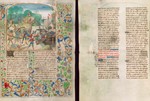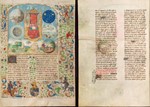Treasure of wisdom. From Creation of the World to 138
Content: text (58 symbols)
Uploaded: 01.12.2018
Positive responses: 0
Negative responses: 0
Sold: 3
Refunds: 0
Seller: Protohistory
$0.55
This richly decorated manuscript entitled "Trésor de sapience" ("The Treasure of Wisdom") is devoted to world history from the Creation of the World to the year 138 of our era. It was created around the years 1470-1480, probably in Bruges, and is illuminated by colleagues Luaz Liéde and Willem (or Guillaume) Vrelant. In itself, this book serves as an excellent example of secular literature, which in the third quarter of the 15th century was in demand among customers from the highest strata of society in the south of the Netherlands. In addition to the luxurious decoration, this historical work is characterized by the presence of important information from the field of heraldry. The most recent heraldic shield, depicted on a faded background, belonged to Adolf Burgundy, the lord of Beveren, Vera and Vlissingen (died in 1540). In 1516, Adolph of Burgundy, following his father, Philip of Burgundy, and his grandfather, Antoine of Burgundy ("The Great Bastard of Burgundy", illegitimate son of Philip the Good), became a knight of the Order of the Golden Fleece. The artistic design of the manuscript and its organization throughout the text reflect the principles of the hierarchical structure of the composition and creative collaboration characteristic of large-scale graphic projects in secular publications of this kind. Six large miniatures with two columns of text, which precede all the main sections of the chronicle, deserve special attention. These illustrations are distinguished by exceptional expressiveness, stylistic variety and elegance of execution. The main focus of the illustrations is on the image of the Holy Trinity, which is clearly expressed on the frontispiece, which in six medallions depicts the cycle of the Creation of the World. This manuscript echoes the teaching of St. Augustine about the Trinity, related to the six days of Creation, the six ages of man and the six ages of the world. It discusses a combination of biblical and secular themes, in particular, the history of Thebes, Troy and Britain; third era of the world; the history of Rome from Romulus and Remus to the victory over the Gauls and the rule of the Roman emperors, ending with Adrian (died 138 AD); the reign of the Italian kings, beginning with Aeneas, as well as the epoch of Alexander the Great and the preceding rulers. In the text of this work, made by the Burgundian letter of a letter of Bardat, the handwriting of several scribes is traced.



